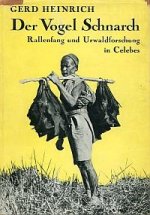the Germans. In the summer of 1939 he therefore built a hiding place in the marshes of Borowke, hermetically soldering his most valuable Ichneumonid wasps, the types of new species, in a tin box which he buried. When Poland was overrun by the Germans, he was considered politically suspect by his former country-men because of his Polish sympathies. Warned by a neighbour, he took action and approached his superior in ww I, Grauert (now a general), asking to be accept-ed as a volunteer. Thus he again served as a pilot in the German air force.
Towards the end of the war Heinrich made arrangements for him and his family to flee from the approaching Russians. They had a narrow escape and were unable to travel together, but in the end they were all united in the American Occupation Zone. Only Lieselotte decided to stay in Poland. Having managed to cross from the Russian into the American Zone just in time, they all lived in a but in a nature reserve near Trittau (Schleswig-Holstein) for a time. Heinrich tried finding a job anywhere except in eastern Europe. Finally, in 1947, he found an American sponsor to help them emigrate to the United States, a rich industrialist. However, the sponsoring was only for a 'standard' family and Heinrich now had to make a choice. To resolve the dilemma, he divorced Anneliese and married Hilde, eventually emigrating with his new wife and their two children. Ulla and her husband, a Pole in the Royal Air Force, later emigrated separately, taking Anneliese with them as their relative. Once in the States Anneliese began a new life in Chicago, away from Heinrich.
Heinrich's American sponsor hoped he might exploit his protege's potential, for example by expecting Heinrich to ghost-write a PhD thesis for him. Heinrich then decided to sever all ties with his former patron and moved to an old farm in Maine which Gerd and Hilde had found. Gerd earned some money by selling timber from his land and selling small collections of specimens to American museums. Raymond Hall, a specialist in mammals associated with the University of Kansas, offered him the chance to go on a collecting journey in Mexico. The trip was not entirely satisfactory as it left him little time for biological observations; also, he was not allowed to publish any interesting observations of his own.
The Field Museum in Chicago then gave him the opportunity to collect birds and mammals in Angola. Heinrich and Hildegarde went on two expeditions to Angola, in 1953-1955 and in 1956-1958. A final expedition, to Tanzania, followed in 1961-1962. This may well have been the world's last traditional collecting journey to have been undertaken!
For many years Heinrich worked on his magnum opus, a monograph on the Ichneumonidae of Burma and Sulawesi. In ww II he had entrusted a copy of his manuscript to a friend, who had it deposited somewhere in Thuringen. In 1946 an adventurous zoology student called Dieter Kramer was willing to cross the border into East Germany at night and brought back the manuscript next day. The first seven instalments of Heinrich's work appeared in the Swedish journal Entomologisk Tidskrift. The later instalments were published by the Polish Academy of Sciences following a change of policy of the journal, which decided to accept only papers dealing with Scandinavia. That such a thing was possible as the Cold War was at its height is due to the special fate of Heinrich's collections. When the Poles found Heinrich's collections intact on Borowke estate in 1945, they were transported to the Zoological Institute of the Polish Academy of Sciences. When Heinrich in a letter to Bódon Pisarski, director of the Zoological Institute and an expert on the Ichneumonidae himself, told him where to find his tin box with type specimens, Pisarski went to Borowke and was indeed able to dig up the box intact. In the interest of science, the Polish Academy lent Heinrich his own collections for study purposes, to enable him to complete his monograph. It is a remarkable foot-note in the otherwise mostly grim history of the Cold War. The last instalment of the monograph appeared in 1980.
Heinrich's later Ichneumonid collections from Africa and America were sold to Munich in 1980 — Harvard and the Smithsonian offering far too little to Heinrich's liking.
After 1975 Heinrich's health gradually declined. He died on 16 December 1984. His son Bernd, now retired, rose to become a renowned biologist in the United States.
1932
Der Vogel Schnarch. Zwei Jahren Rallenfang and Urwaldforschung in Celebes. Berlin: Dietrich Reimer/Ernst Vohsen. Description: 198, illus.
¶ 1943, republished under the title Celebes. Seltsame Jagd durch ein seltsames Land. Berlin: Dietrich Reimer/Andrews & Steiner. Description: 198.
¶ 1950, Auf Rallenfang in Celebes. Berlin: Palmen-Verlag (vorhin Reimer). Description: 86, 8 pages halftone photogr. I do not know whether this is the original publication with a more parsimonious layout, or an abridgement of the original text.
1933
Auf Panthersuche durch Persien. Berlin: Dietrich Reimer/Ernst Vohsen. Description: 159, illus.
1940
In Burmas Bergwalden Forschungsreise in British-Hinterindien. Berlin: Dietrich Reimer. Description: 182, 32, illus.
¶ 1942 Reprint. Berlin: Dietrich Reimer (Andrews & Steiner). Description: 182, illus.







